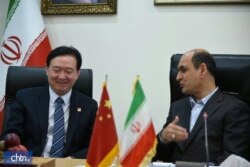Iran has banned air travelers from China in an effort to keep out the coronavirus, crippling an already-faltering Iranian program to boost Chinese tourism as a way of stimulating an economy crushed by U.S. sanctions.
In a tweet Friday, Iranian Health Minister Saeed Namaki said an emergency meeting of government officials had approved his request to ban all flights to and from China until further notice.
Iranian state-approved news agency Fars reported the travel ban in a Friday article citing Namaki’s tweet.
Namaki also said Iranians who want to leave China, the center of a deadly coronavirus outbreak labeled a global health emergency by the World Health Organization, will have a medical escort back to Iran.
Friday’s announcement was the biggest blow yet to a 6-month-old Iranian government initiative to massively increase Chinese visitors and tourism to the country, which has seen its other economic sectors greatly weakened by U.S. sanctions that have been tightening since 2018.
Iranian state news agency IRNA acknowledged the coronavirus as one of a “series of recent crises” to hit Iran’s tourism industry in an article published Thursday.
Other crises that afflicted Iran in January included its most intense outbreak of fighting with the U.S. in their decades of tense relations, with the U.S. killing Iran’s top general Qassem Soleimani in a strike on Baghdad and Iran retaliating with a missile attack on an Iraqi base housing U.S. troops. Iranian forces also mistakenly shot down a Ukrainian passenger jet shortly after it took off from Tehran en route to Kyiv, killing all 176 people on board.
The turmoil prompted China’s tourism ministry to issue a Jan. 9 alert, advising Chinese citizens in Iran to pay close attention to the regional security situation and take greater precautions for their personal safety.
Iranian officials had been more optimistic about their prospects for ramping up Chinese tourism last July, when they unilaterally scrapped visa requirements for Chinese citizens and allowed them to stay in Iran visa-free for 21 days after each entry.
At the time, Iranian Minister of Cultural Heritage, Handicraft and Tourism Ali Asghar Mounesan told IRNA that Tehran was seeking to boost its non-oil revenues through tourism, an industry it deemed impervious to U.S. sanctions. Iran has relied for years on oil exports as its primary revenue source, but has seen that revenue dwindle since the U.S. unilaterally banned all nations from buying Iranian oil last May.
In announcing the visa waiver program, Mounesan said it was Iran’s goal to bring 2 million Chinese tourists and business travelers to the country annually in the coming years. That would be a huge increase from the 52,000 Chinese visitors whom Iranian officials have said entered the country in 2018.
When Mounesan traveled to Beijing in November for a tourism conference, IRNA quoted him as somewhat tempering that goal, saying Iran wanted to expand Chinese tourism to 1.5 million visitors annually over a period of four to five years.
In a sign that the visa waivers were not doing much to move Iran toward that lofty target, Mounesan’s deputy, Vali Teymouri, told Iranian state media that Chinese visitor arrivals remained low in the months after the program’s launch.
In comments reported by the ISNA news agency in November, Teymouri said 14,000 Chinese nationals entered Iran in a three-month period from July to October, up from 13,000 visitors in the same period the year before. In December, Teymouri told the Donya-e-Eqtesad newspaper that Chinese visitor arrivals for the seven-month period from March to October reached 28,000.
Chinese Ambassador to Iran Chang Hua noted the incremental nature of the visitor growth on a trip to northeastern Iran’s Golestan province in November. Iran’s tourism ministry website quoted him as saying, “the number of Chinese tourists in Iran has increased … but is still far from the desired goal.”
Disappointed visitors
Iran long has been a problematic destination for Chinese visitors.
One of them, a well-travelled Chinese blogger who goes by the name Atlantic Eel, posted a Jan. 6 commentary titled: “Why I don’t recommend traveling to Iran.” In the blog, filled with photos of Iran from his recent visit, he said its religiously conservative society undermined his travel experience by making opportunities for secular activities such as eating, drinking, listening to music and accessing the Internet “extremely scarce.”
Ahmad, a Tehran-based Iranian guide for Chinese tour groups, told VOA in a phone interview that he had seen an increase in Chinese visitors during the summer months of mid-2019, but noticed they were not happy with the service they received from what he called Iran’s under-developed tourist infrastructure.
“Chinese tourists tend to prefer receiving information in their mother tongue, but Iran has not done much to provide them with Chinese-language brochures and guidebooks,” he said.
Ahmad said gaps in cultural understanding between Chinese visitors and their Iranian hosts were another problem.
“Most female Chinese visitors complained about the Islamic headscarf they were required to wear in public and some of them had difficulties in doing so,” he said.
The Iranian tour guide said he recently had traveled with one Chinese group from Iran into neighboring Turkey.
“They felt like they had been freed from a prison when they arrived in Turkey, with many Chinese restaurants to choose from and a better understanding of their needs,” he said.
For many people in China, Iran is seen as destination for the adventurous or those with business interests.
Jack Huang, founder of a Beijing-based education start-up company, told VOA Mandarin that not many people travel to Iran besides those who work for Chinese state-owned oil companies or weapons manufacturers.
“In general, Chinese people prefer go to countries where travel is cheap, you can shop and it is safe,” he said. “The security situation in Iran indeed is a big concern for us.”
Atlantic Eel, the Chinese blogger, wrote that when he asked fellow Chinese travelers in Iran if they liked the country, most answered yes. But when he asked if they would choose to live there, he said most of them hesitated and said they preferred only to visit.
"If you really liked a country, you would have a desire to live there,” he opined.
This article originated in VOA’s Persian Service. It was produced in collaboration with VOA’s Mandarin Service and Extremism Watch Desk.











